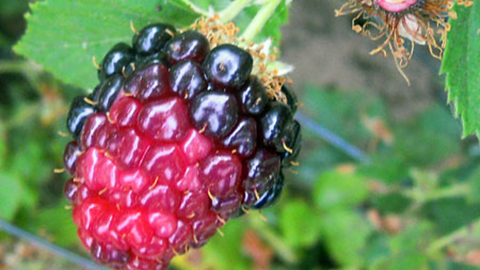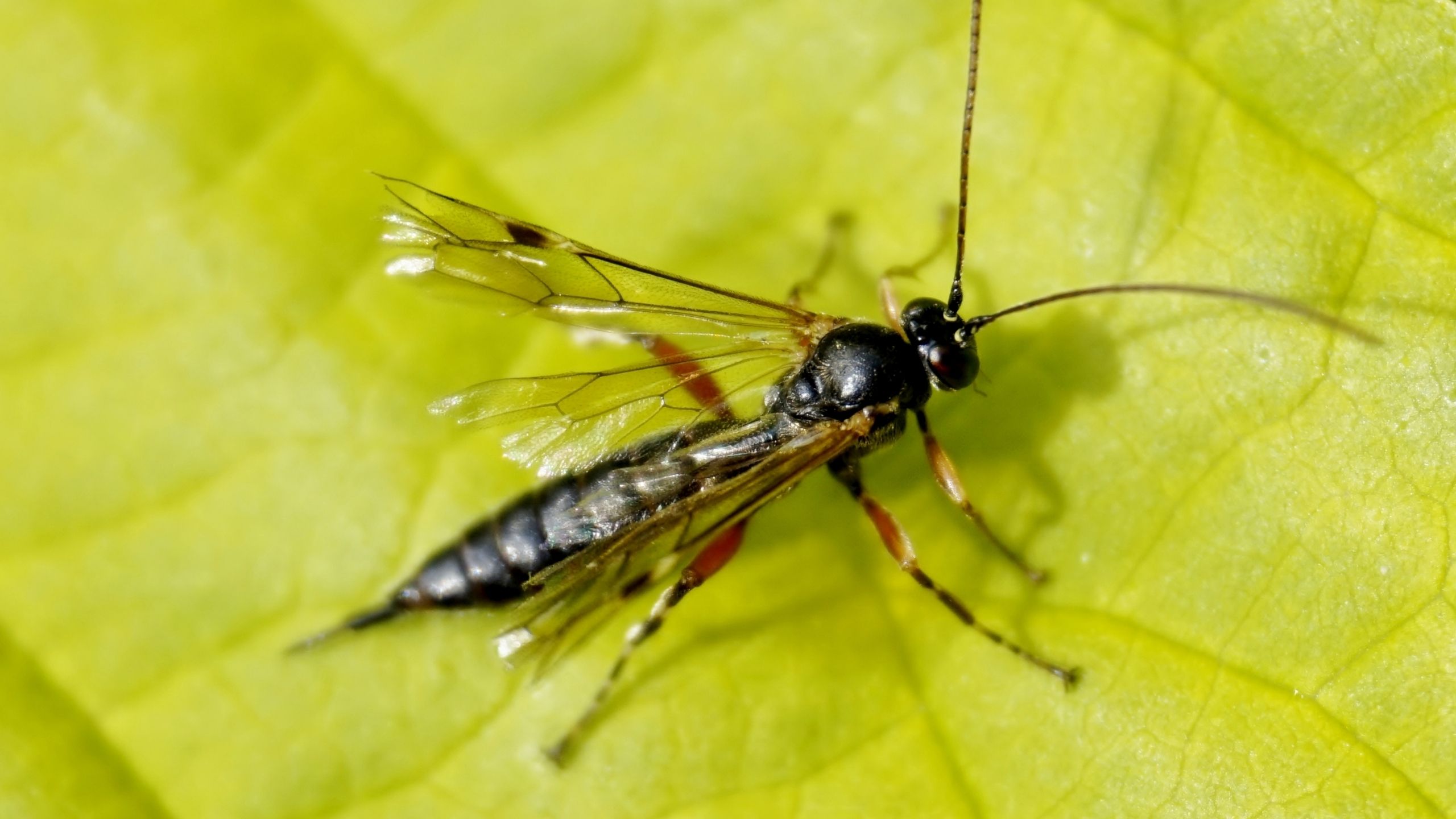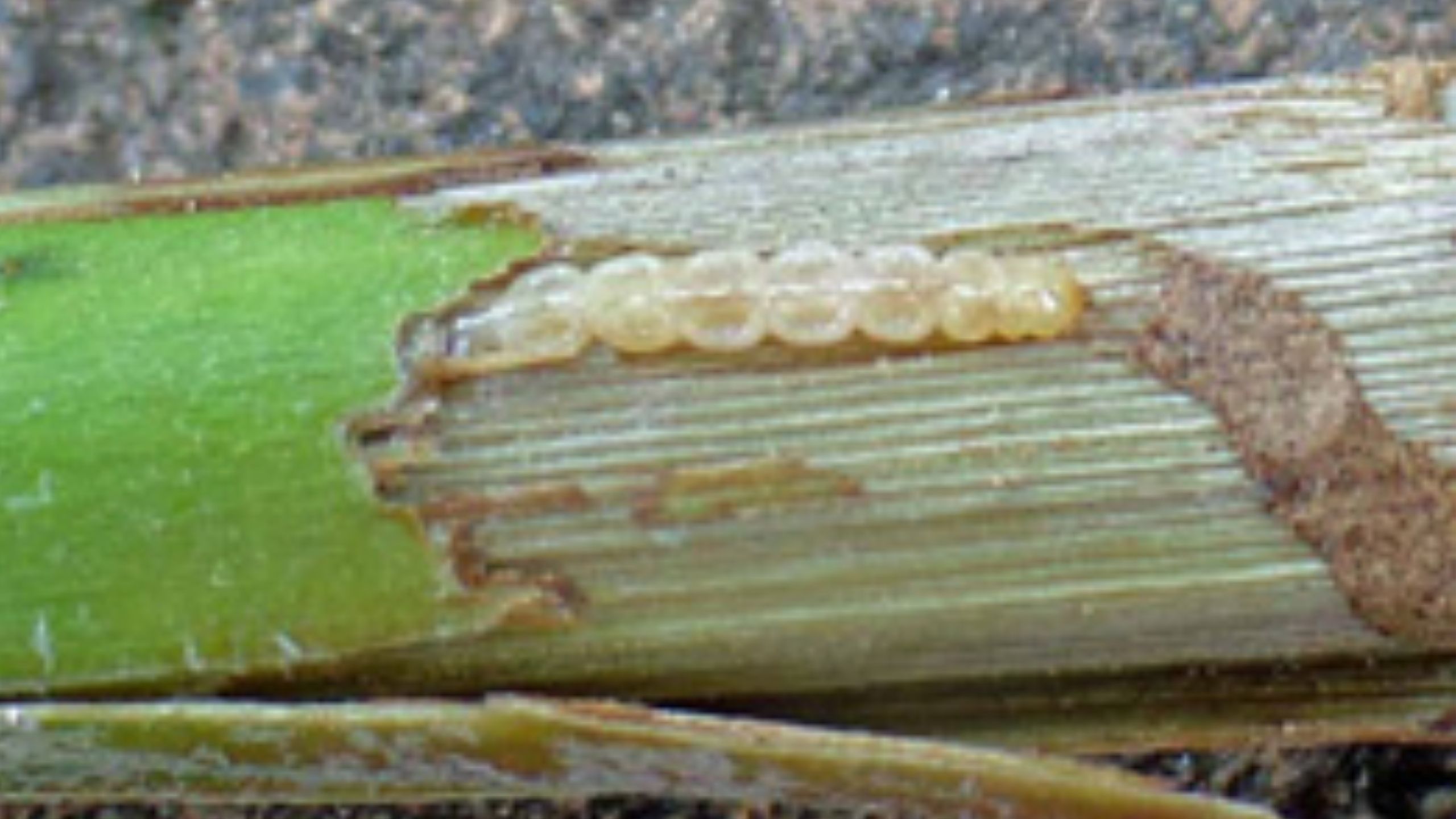Spider Mites in Raspberry
May 2017
Diane Alston, Extension Entomologist (No longer at USU)
Quick Facts
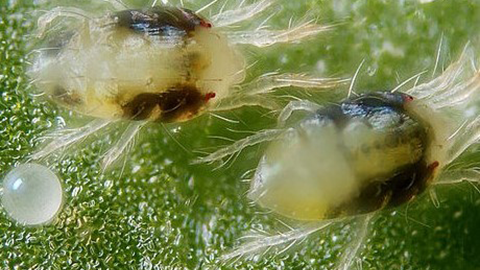
- ‘Mite burn’, a golden to brown bronzing of leaves, caused by spider mite feeding can be severe in raspberry plantings; it is typically first observed on the lower leaves.
- Spider mites overwinter at the base of canes, under organic duff, and on weeds; mites climb into raspberry plants as conditions becomes hot and dry.
- An integrated management approach includes planting hardy grasses in alleyways, avoiding dust on leaves, avoiding plant stress from insufficient water and nutrients, shading, cooling with overhead sprinklers, and proactive application of chemical miticides, when needed.
Spider mites can be a challenging pest of raspberry. The twospotted spider mite (Tetranychus urticae Koch) is the most common mite to attack raspberry in Utah (Fig. 1). Spider mites are small eight-legged arthropods (adult females are only 1/60 inch, 0.5 mm, long), but populations can build quickly to high numbers during hot, dry conditions. Spider mites typically feed on the underside of leaves and form colonies with webbing to protect the eggs and nymphs. They overwinter as females (dormant females are orange in color) at the base of canes, under organic duff, and on adjacent weeds and ground cover plants. Mites suck the sap from leaves which causes a fine, white to gray stippling (very fine dots), and they can complete a generation in as little as 10-14 days during the summer.
Plant Injury
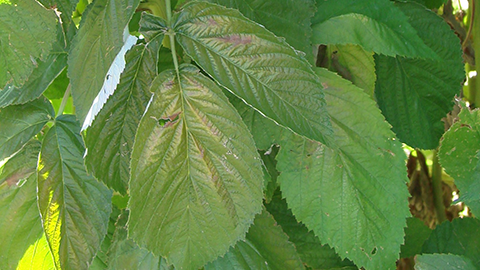
The hot, dry summer conditions of Utah promote spider mite populations that can cause ‘mite burn’, a golden bronzing, typically seen on the lower leaves first (Fig. 2). Mites begin feeding on ground vegetation in the spring, and then climb into the raspberry plants as the ground cover dries out and the mite numbers increase. Raspberry leaves are highly sensitive to mite feeding. Mites cause damage to raspberry through reduced photosynthesis that leads to reduced cane vigor and berry yield, and weakened primocanes that are predisposed to winter injury.
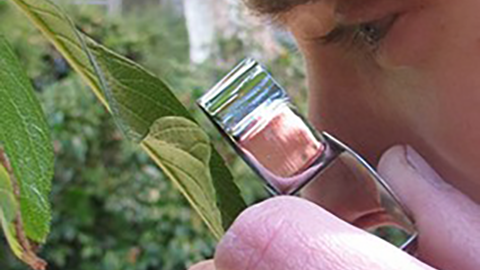
Monitoring
It is important to scout for mite and predator populations during the season to determine if chemical control is necessary, and if so, to optimally time treatments. Sampling should begin when mites first climb into canes and visual feeding injury (white to gray stippling on leaves) is observed. Effective methods include shaking lower canes and leaves (where mites show up first) over a light-colored sheet or tray. Look for ‘moving specks’. Use a hand lens (10-30× magnification) (Fig. 3) to observe mites and natural enemies (see Biological Control section). Scout for early leaf bronzing on lower canes.
Management
An integrated approach combines cultural, biological and chemical methods to prevent crop loss and keep canes healthy.
Cultural Control
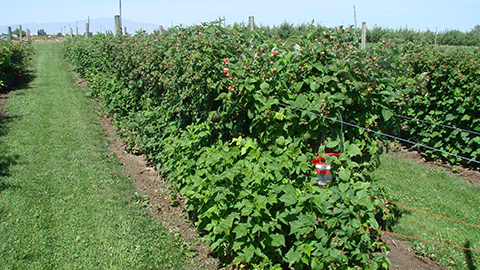
- Plant a hardy grass or vegetation mix in alleyways (spaces between rows) to minimize broadleaf weeds (Fig. 4); spider mites prefer to feed on field bindweed, common mallow, knotweed and other common broadleaf weeds.
- Avoid disturbing the ground cover and spreading dust onto foliage, which promotes mite dispersal into raspberry plants.
- Avoid plant stress, including water and nutrient stress, as stressed plants are more susceptible to attack by mites.
- Install overhead sprinklers to cool and moisten foliage and berries during hot periods to reduce mite populations (Fig. 4).
- Install shade covers to cool plants and reduce spider mite population growth rate.
- Select cultivars with hairy leaves to deter mite feeding.
- If growing raspberries in macro-tunnels, provide good ventilation and temperature management to avoid hot, dry conditions.
Biological Control
There are natural predators that regulate spider mite populations. The most important natural enemy is the western predatory mite, Galendromus (Typhlodromus) occidentalis (Nesbitt) (Fig. 5a). Additional generalist predators include western flower thrips (Fig. 5b), minute pirate bug (Fig. 5c), big-eyed bug, the spider mite destroyer ladybeetle (Fig. 5d), and lacewings. Avoid toxic insecticides and miticides to protect natural enemies. In addition, supplemental releases of insectary-reared predators can reduce mites, but is generally better suited to enclosed production systems, such as tunnels and greenhouses.
Chemical Control

Chemical options for spider mites in raspberry include those that are least disruptive and those with organic formulations, such as neem (azadirachtin) oil, horticultural oil, insecticidal soap and sulfur (do not apply sulfur when ambient temperatures are above 80°F and within one month of an oil spray, due to phytotoxicity).
Miticides registered for commercial operations include etoxazole (Zeal), hexythiazox (Savey), acequinocyl (Kanemite), bifenazate (Acramite), and fenbutatin-oxide (Vendex).
Savey and Zeal are mite growth inhibitors, and only effective against mite eggs and nymphs. Apply these products at the first sign of adults laying eggs. Savey and Zeal are ineffective as ‘rescue treatments’. Acramite, Kanemite and Vendex are active against adults as well as nymphs. Vendex is toxic to predators; avoid it when predators are active.
Spider mites are notorious for developing resistance to miticides; read the product label for the mode-of-action group, and rotate among chemical groups. Also, check the label for the pre-harvest interval (time required between application and crop harvest), re-entry interval (time required between application and re-entry to the field), and the number of applications allowed per season. When raspberry fruit are ready for harvest, it is critical to select products that are appropriate for the picking schedule.
In summary, an integrated mite management program uses multiple tactics and relies on frequent scouting to detect mite populations before they cause harm to plants and yield. Some useful pest management resources for raspberry include the Utah State University (USU) Extension Fruit IPM Advisory (sign up here for a free subscription), USU Extension small fruit pest fact sheets, and the Pacific Northwest Insect Management Handbook.
Related Research


